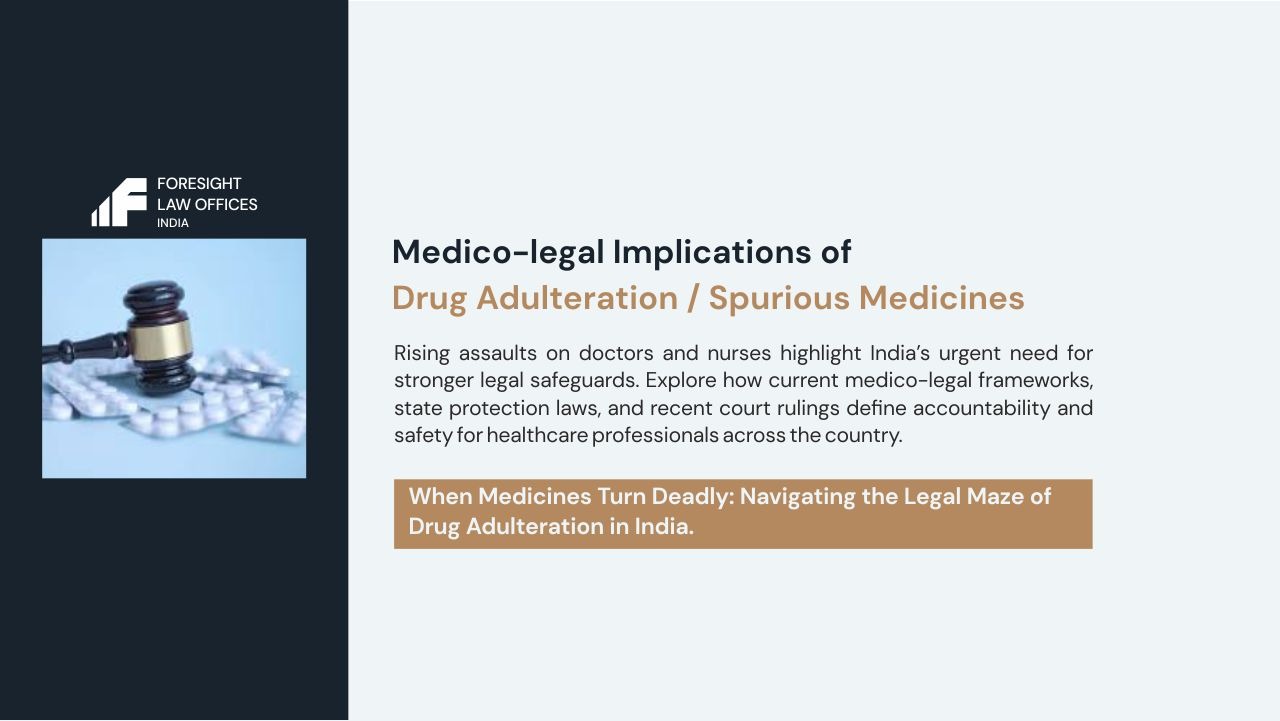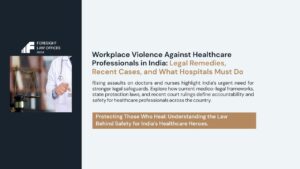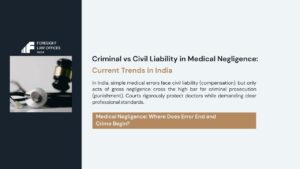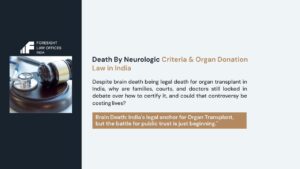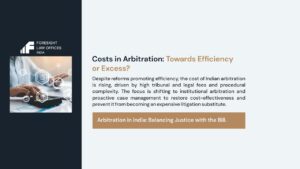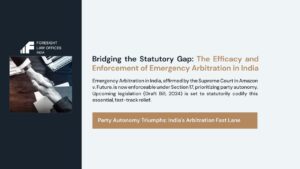Introduction
The specter of drug adulteration and spurious (counterfeit, misbranded, contaminated) medicines is not new in India, yet when tragedies occur (e.g. children dying after consuming contaminated cough syrup) the legal glare often falls on multiple actors: manufacturers, regulators, and sometimes prescribing doctors. For a medical law lawyer or medico-legal adviser, it is vital to understand how liability may be apportioned, what defenses may exist, and how the law and courts have responded in recent years.
In 2025, India is confronting a renewed crisis of cough syrup toxicity linked to diethylene glycol contamination, triggering criminal probes, regulatory bans, license cancellations, and calls for systemic reform. In that context, this article maps the legal terrain: statutory regimes, circumstantial liability, defenses, recent incidents, and risk mitigation pointers.
Legal Statutes & Regulatory Framework
Drugs & Cosmetics Act, 1940 (and Rules, 1945)
This Act is the principal statutory anchor regulating manufacture, sale, quality, labeling, adulteration, and spurious drugs in India. Key relevant sections:
| Sections | Regulating |
| Section 33EE | Adulterated drugs (if the drug’s strength, quality, purity is below standard or injurious to health). |
| Section 33EEA | Spurious drugs (various categories: misbranded, imitation, false claims, etc.). |
| Section 27 | Penalty for manufacture, sale, etc., of adulterated or spurious drugs: punishment not less than 10 years (may extend to life) plus fine. |
| Section 32A | The Act also empowers courts to implead manufacturers, distributors, and dealers in liabilities and to compound certain offences under rules. |
Additionally, CDSCO and State Drug Control Authorities enforce the law through inspections, sample testing, recalls, license cancellation and prosecution.
Other statutes & common law
- Consumer Protection Act, 2019 / earlier consumer regime: A harmed patient or consumer may sue for a deficiency in service or product under “service” or “goods” theories. If a medicine is proven to be adulterated, that can be a ground for consumer liability.
- Criminal law (Bharatiya Nyaya Sanhita / prior IPC): Intragovernmental prosecutions under sections such as causing death by negligence, culpable homicide not amounting to murder, etc., may be triggered, depending on facts.
- Regulatory and administrative sanctions: License cancellation, show-cause orders, recalls, and injunctions.
- Tort / negligence claims: Patients may sue doctors/hospitals, though in many cases the primary defendant is the manufacturer/regulator.
One challenge is that the law and case horizons in India still lag in clarifying when doctors (versus manufacturers) may bear significant liability in adulteration cases.
When Doctors Get Blamed vs Manufacturers / Regulators
Doctors’ Exposure: Under What Theories?
Doctors may be drawn into liability in adulteration/spurious drug cases under several potential theories (though liability is less direct than manufacturers’):
- Negligent prescribing / failure to verify drug source
If a physician prescribes or dispenses a medicine from a dubious supplier (e.g. non-licensed source) and a patient is harmed; a plaintiff may claim negligence. But to prevail, the plaintiff must show that a competent doctor would not have prescribed that product or would have ensured safer supply.
- Causation attribution
Often the harm is from contaminated or adulterated product; showing that the doctor’s prescribing decision materially contributed to harm (or failed to detect early signs) may invite partial liability.
- Liability under criminal statutes
In some high-profile investigations, doctors have been included in FIRs under broad charges (e.g. criminal negligence) especially when the prescribing behavior or monitoring is alleged to be lax, or the doctor did not follow “standard practice” warnings. However, successful prosecution requires proof of gross negligence, not mere error of judgment.
- Vicarious or institutional liability
A hospital or institution may bear responsibility for prescribing policies, procurement standards, or quality control oversight for pharmacy operations. If a hospital’s internal procurement system is lax, and that leads to the distribution of adulterated drugs to patients, the institution (and indirectly its doctors) may be implicated.
However, courts and regulatory bodies usually treat doctors with greater caution given their limited control over manufacturing, unless there is clear dereliction. A medical law lawyer defending a doctor in such context would emphasize that the core breach lies at the manufacturing/supply/regulation end.
Manufacturers / Regulators: The Core Liability
- Strict liability under Drug Acts
Manufacturers who produce adulterated or spurious drugs are liable under the Drugs & Cosmetics Act, facing imprisonment (10 years to life) and heavy fines.
- Recall, withdrawal, license cancellation
Regulatory authorities can order immediate recall of products, suspend or cancel manufacturing licenses, and bar sales of affected batches.
- Criminal prosecutions / manslaughter / culpable homicide
In cases where adulteration leads to death (especially multiple deaths), authorities may invoke criminal liability—not just drug law, but more severe charges such as culpable homicide not amounting to murder or manslaughter.
- Regulator oversight / negligence
In some scenarios, plaintiffs may sue regulators or government agencies for failing to enforce standards, but this is tricky in India due to sovereign immunity and the challenge of showing actionable duty in tort.
- Civil / consumer liability
Victims may claim compensation via consumer litigation or tort claims against the manufacturer, seller, or distributor.
Thus, in adulteration cases the legal spotlight more heavily aims at manufacturers and regulators, but doctors can still be drawn in under certain fact patterns.
Defenses & Exculpatory Arguments
When a defendant (doctor, hospital, manufacturer) is challenged, several defenses are available:
- Absence of knowledge / lack of mens rea
Particularly for doctors, the claim that they were unaware the medicine was adulterated, if they acted in good faith and used standard suppliers, can be strong. To convict, prosecutors must establish knowledge or recklessness.
- Causation gap / intervening act
If harm was caused not solely by the adulterated product but by intervening acts (patient noncompliance, other disease, delay), the defendant may argue the chain of causation is broken.
- Compliance with prevailing standards
Showing that the doctor or institution followed accepted procurement, prescribing, and monitoring protocols may shield them.
- Statutory immunity / limitation
Some offences may be compoundable or subject to limitation; procedural or jurisdictional defects may be challenged.
- Regulatory compliance defenses
A manufacturer may argue it followed all legally mandated tests, standards, and norms, including Good Manufacturing Practices (GMP) sanctioned by regulators, and that the adulteration was unforeseeable (e.g. raw material contamination despite due diligence).
- Force majeure / contamination at distribution chain
The manufacturer/defendant may try to show that the adulteration occurred downstream (e.g. in transport, distribution, storage) outside its control.
For a medical law lawyer counseling a doctor or hospital, securing strong procurement records, bills, chain of custody, supplier certifications, standard operating procedures, and drug audit trails is crucial to mount such defenses.
Recent Incidents & How They Are Being Treated
The year 2025 has brought a renewed and tragic reminder: multiple child deaths allegedly linked to contaminated cough syrups have triggered a national crisis. The unfolding events offer instructive lessons on medico-legal dynamics.
2025 India Cough Syrup Crisis (Coldrif, Kayson Pharma)
- In Madhya Pradesh and Rajasthan, dozens of children under five died after consuming a cough syrup brand named Coldrif, manufactured by Sresan Pharmaceuticals (Tamil Nadu). Tests reportedly revealed extremely high levels of diethylene glycol (DEG), a toxic industrial solvent.
- Simultaneously, a separate government scheme cough syrup by Kayson Pharma (Rajasthan), containing dextromethorphan hydrobromide, was implicated in fatalities and hospitalizations.
- The police launched a manslaughter probe, and some doctors prescribing or dispensing the syrups were also named in FIRs.
- Authorities suspended Sresan’s license, banned the product, recalled the stock, and initiated criminal action under the Drugs & Cosmetics Act.
- The central government and WHO have flagged India’s regulatory oversight and called for stricter testing protocols (e.g. mandatory screening for DEG/EG in oral liquid formulations).
These events have strong resonance across medico-legal, regulatory, criminal, and civil domains:
- Prosecutors are treating manufacturer actions as not only drug law violations but as criminal culpability in child deaths.
- Courts and public opinion may put pressure on prescribing doctors, although many medical associations argue doctors should not be scape-goats contamination is upstream.
- Regulators are likely to enforce more stringent sample testing, audit trails, licensing scrutiny, and liability for raw material sourcing. News reports note that states like Telangana have mandated complex screening for industrial solvent contaminants.
Historically, India has also been implicated in international adulteration scandals (notably the Uzbekistan cough syrup scandal, where Indian-made syrups were blamed for dozens of child deaths abroad). That case exposed global supply chain liability and regulatory export oversight lag.
These incidents underscore the perils when adulteration is not viewed as isolated but systemic, involving raw materials, manufacturing, oversight, regulator inertia, and distribution chains.
Legal Implications & Lessons for Medical Practitioners
- Escalating scrutiny on prescribing habits
While doctors will rarely be primary offenders in a spurious drug case, in high-stakes controversies they may face FIRs or professional disciplinary action. A prescribing doctor must be able to document that:
- The drug prescribed was from a licensed, reputable manufacturer/supplier,
- The batch/expiry/label details were verified,
- The prescription was justified clinically and consistent with standard of care,
- Monitoring adverse events was diligent.
- Standard of care expectations evolve
In contexts of known adulteration risks or prior incidents, judicial expectations may increase: e.g. checking whether a drug brand has prior safety signals, questioning unusual patients complaining of side effects, or switching to more trusted alternatives. A medical law lawyer may need to advise clients to maintain periodic drug safety alerts, internal pharmaco-vigilance, and supplier audits.
- Risk of being dragged into criminal cases
Even if the primary liability lies upstream, doctors may be named FIRs. The defense must press for early quashing petitions, anticipatory bail, and evidence gathering to show absence of gross negligence or mens rea. Courts may differentiate between error in prescribing and prescribing a knowingly adulterated product.
- Encouragement of regulator and manufacturer accountability
The recent syrup crises may spur stricter enforcement, more aggressive actions by Drug Control Authorities, stronger retrospective audits, and tighter raw material control. Manufacturers and regulators will have to defend their test protocols, quality assurance, supply chain oversight, and timely recall procedures.
- Litigation and compensation exposure
Affected consumers (often children, families) may sue manufacturers under consumer law or tort claims. Courts may award heavy compensation. Manufacturers and possibly distributors must anticipate significant civil exposure.
- Institutional / hospital procurement liability
Hospitals or institutions procuring large volumes of medicines (especially in state schemes) may be exposed if they fail to vet supplier credentials or quality assurance mechanisms. Medical law lawyers advising health systems must ensure robust procurement policies, supplier validation, lot testing, third-party batch verification, and recall readiness.
Risk Mitigation: What Medical & Institutional Actors Must Do
- Supplier diligence & certification
Use only licensed, audited pharmaceutical suppliers with documented quality control certifications and trust history. Avoid gray or unverified vendors.
- Batch-level traceability & audit trails
Maintain records of batch numbers, expiry, serial numbers, traceability logs, purchase invoices, storage conditions, quality tests upon arrival, etc.
- Internal drug testing protocols
For high-risk formulations (liquids, syrups), consider random internal testing for contaminants (e.g. DEG/EG) or third-party labs. Set protocols for periodic verification.
- Pharmacovigilance & adverse event monitoring
Create systems to flag adverse events, correlate with drug batches, report internally and to regulators, and act swiftly with recalls if needed.
- Legal & procurement clauses
Draft contracts with indemnity, liability allocation, recall rights, audit rights, product liability insurance, and warranties from manufacturers.
- Training & awareness for clinicians
Clinicians should be sensitized to signs of drug toxicity, prompt reporting, and cautious prescribing in suspect scenarios. If adverse events emerge, immediate reporting to pharmacovigilance systems.
- Crisis preparedness & recall pathways
Institutions should have a recall response plan: halt dispensing of suspect stocks, notify patients, coordinate with regulators, preserve samples, legal coordination with a medical law lawyer. - Regulatory liaison & proactive compliance
Ensure that manufacturing units (if in-house pharmacies) comply with GMP norms, adhere to quality standards, follow CDSCO licensing rules, and keep up with notifications. Stay abreast of regulatory alerts or WHO notices.
Conclusion
The medico-legal implications of drug adulteration or spurious medicines sit at the confluence of public health, regulation, criminal law, and clinical practice. While the legal burden lies most heavily on manufacturers and regulators under the Drugs & Cosmetics Act, doctors and hospitals are not immune—especially in dangerously toxic product episodes. The 2025 cough syrup crisis in India has starkly exposed regulatory gaps, supply chain vulnerabilities, and the potential for tragic loss of life.
For a medical law lawyer, this domain demands deep engagement: defending doctors when unfairly drawn in, advising institutions on procurement and risk frameworks, litigating consumer claims, and contributing to systemic reform initiatives. In clinic and courtroom alike, the motto must be: “document, audit, verify, and recall”, because when medicines fail, lives are at stake, and legal exposure multiplies.

